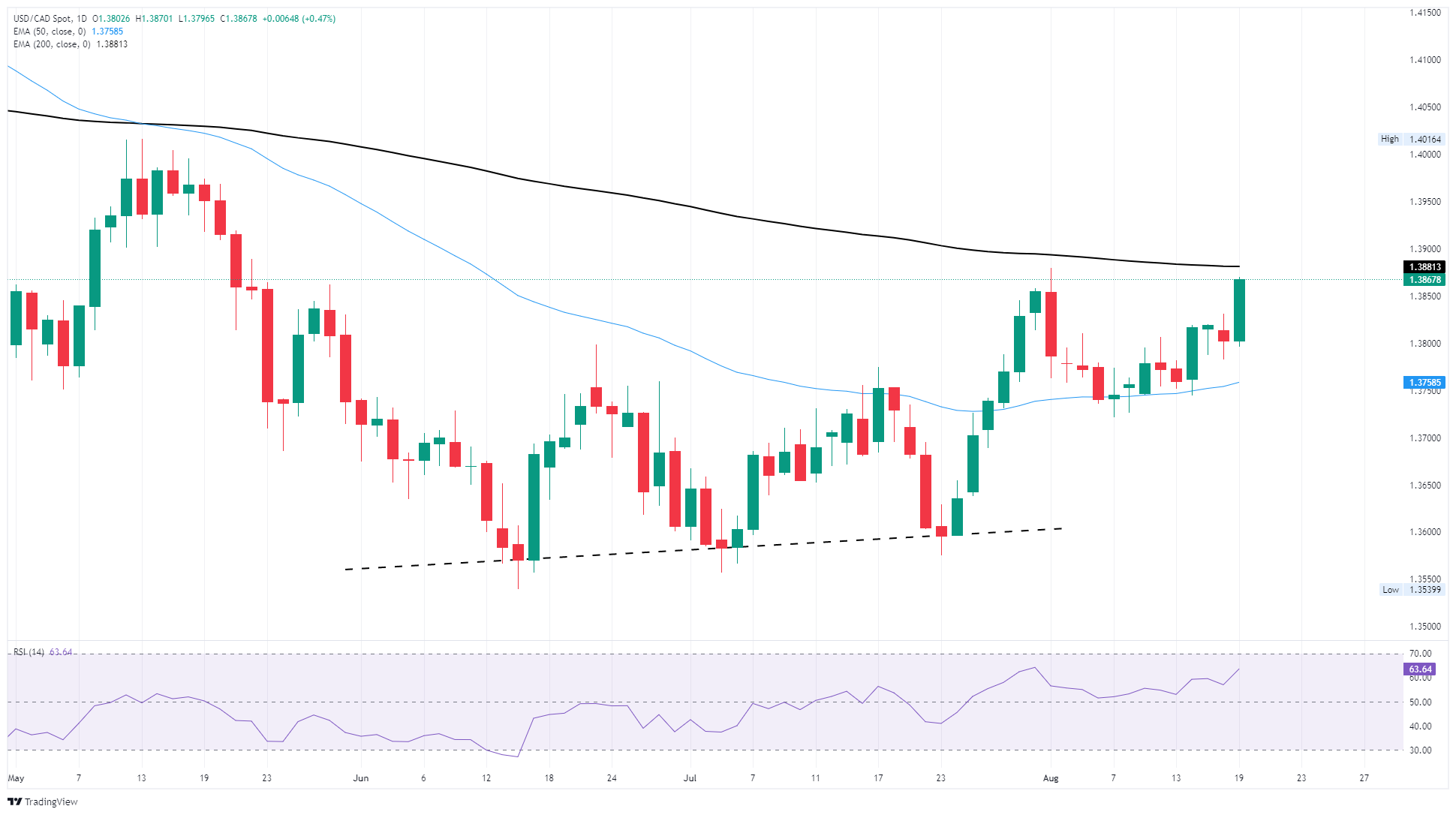Canadian Dollar weakens after Canadian CPI eases faster than expected
- The Canadian Dollar lost further ground against the US Dollar on Tuesday.
- Canadian CPI inflation eased more than expected in July, knocking back the Loonie.
- Despite easing inflation pressures, headline inflation metrics are still far above BoC targets.
The Canadian Dollar (CAD) shed further weight on Tuesday, declining against the US Dollar (USD) after Canadian Consumer Price Index (CPI) inflation figures showed a slight easing in headline figures. Despite cooling headline figures, expectations of easing price pressures for consumers remain subdued as still-rising costs for everyday items get offset by fuel price reductions after the federal government axed key carbon taxes.
Rate market bets on the next Bank of Canada (BoC) interest rate cut remain largely unchanged, with median expectations forecasting that the Canadian central bank will continue to stand pat on interest rates until late January. Mixed inflation data bodes poorly for a clear path forward for the BoC, and when coupled with lagging employment numbers through the second quarter, makes it difficult for the BoC to justify dropping rates any further.
Daily digest market movers: Canadian Dollar retreats on complicated CPI inflation print
- The Canadian Dollar fell nearly one-half of one percent against the US Dollar on Tuesday.
- USD/CAD was driven to its highest bids in over two weeks following Canadian CPI inflation data.
- Common CPI held steady at 2.6% YoY, while the BoC’s Trimmed Mean CPI held steady at 3.0%.
- Headline CPI ticked higher to 0.3% MoM, also as expected.
- Despite a slight easing overall inflation pressures, the BoC still lacks room to make interest rate cuts thanks to declining hiring figures in the second quarter.
- Economists are equally divided on whether or not the Bank of Canada will be able to justify a rate trim in time for its next rate call in September.
USD/CAD price forecast
Tuesday’s bearish Loonie flows pushed USD/CAD back into multi-week highs, and the pair is now poised to close higher for the second week in a row if momentum holds through the end of the week. USD/CAD is inching back toward the 200-day Exponential Moving Average (EMA) near 1.3880, which should provide significant technical resistance for bidders to contend with.
USD/CAD daily chart

Canadian Dollar FAQs
The key factors driving the Canadian Dollar (CAD) are the level of interest rates set by the Bank of Canada (BoC), the price of Oil, Canada’s largest export, the health of its economy, inflation and the Trade Balance, which is the difference between the value of Canada’s exports versus its imports. Other factors include market sentiment – whether investors are taking on more risky assets (risk-on) or seeking safe-havens (risk-off) – with risk-on being CAD-positive. As its largest trading partner, the health of the US economy is also a key factor influencing the Canadian Dollar.
The Bank of Canada (BoC) has a significant influence on the Canadian Dollar by setting the level of interest rates that banks can lend to one another. This influences the level of interest rates for everyone. The main goal of the BoC is to maintain inflation at 1-3% by adjusting interest rates up or down. Relatively higher interest rates tend to be positive for the CAD. The Bank of Canada can also use quantitative easing and tightening to influence credit conditions, with the former CAD-negative and the latter CAD-positive.
The price of Oil is a key factor impacting the value of the Canadian Dollar. Petroleum is Canada’s biggest export, so Oil price tends to have an immediate impact on the CAD value. Generally, if Oil price rises CAD also goes up, as aggregate demand for the currency increases. The opposite is the case if the price of Oil falls. Higher Oil prices also tend to result in a greater likelihood of a positive Trade Balance, which is also supportive of the CAD.
While inflation had always traditionally been thought of as a negative factor for a currency since it lowers the value of money, the opposite has actually been the case in modern times with the relaxation of cross-border capital controls. Higher inflation tends to lead central banks to put up interest rates which attracts more capital inflows from global investors seeking a lucrative place to keep their money. This increases demand for the local currency, which in Canada’s case is the Canadian Dollar.
Macroeconomic data releases gauge the health of the economy and can have an impact on the Canadian Dollar. Indicators such as GDP, Manufacturing and Services PMIs, employment, and consumer sentiment surveys can all influence the direction of the CAD. A strong economy is good for the Canadian Dollar. Not only does it attract more foreign investment but it may encourage the Bank of Canada to put up interest rates, leading to a stronger currency. If economic data is weak, however, the CAD is likely to fall.






